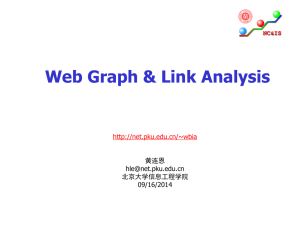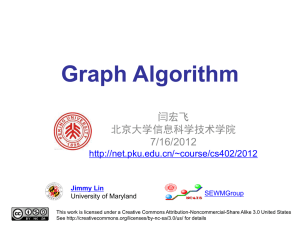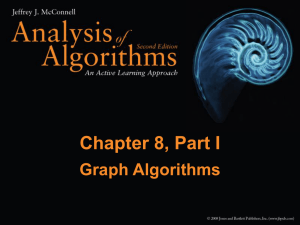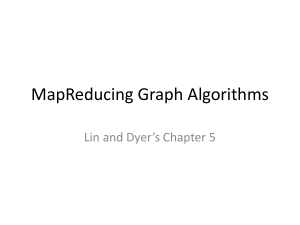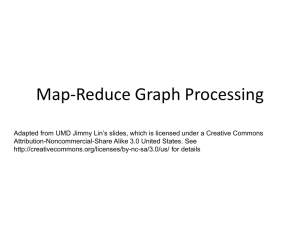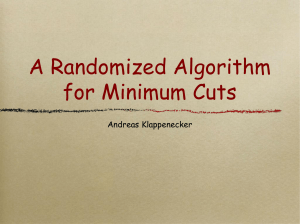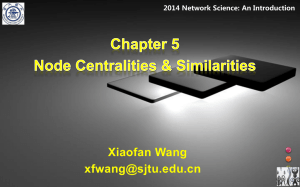PPT
advertisement
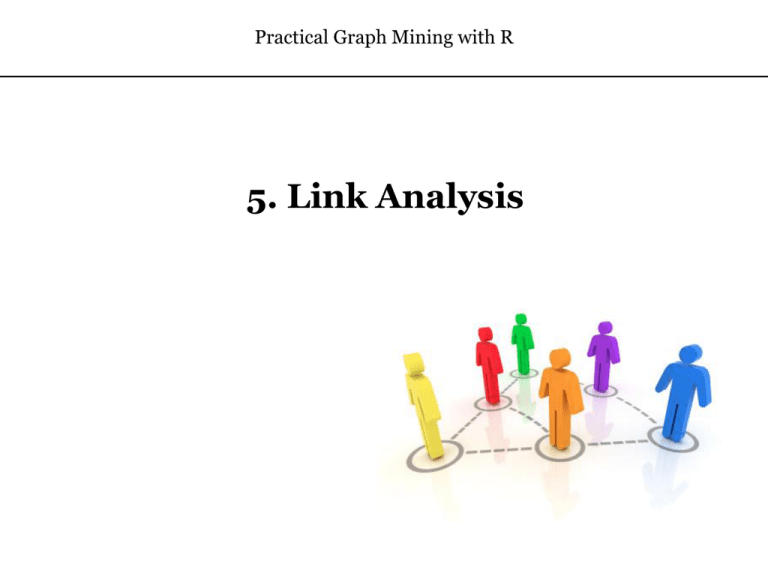
Practical Graph Mining with R
5. Link Analysis
Outline
•
•
•
•
•
Link Analysis Concepts
Metrics for Analyzing Networks
PageRank
HITS
Link Prediction
2
Link Analysis Concepts
• Link
A relationship between two entities
• Network or Graph
A collection of entities and links between them
• Link Analysis or Mining
Using links to establish higher-order relationships among entities
(such as relative importance in network, isolation from other
entities, similarity, etc.)
3
Link Analysis Tasks
• Link-based Object Classification (LOC)
– Assign class labels to entities based on their link characteristics
– E.g. Iterative classification, relaxation labeling
• Link-based Object Ranking (LOR)
– Associate a relative quantitative assessment with each entity
using link-based measures
– E.g. PageRank, HITS, SimRank
• Link prediction
– Extrapolating knowledge/pattern of links in a given network to
deduce novel links that are plausible, and may occur in the future
– E.g. Recommendation systems, infrastructure planning
4
Outline
•
•
•
•
•
Link Analysis Concepts
Metrics for Analyzing Networks
PageRank
HITS
Link Prediction
5
Metrics for Analyzing Networks
• Analysis of relationships and
information flow between
individuals, groups,
organizations, servers, and
other connected entities
• Social Network Analysis (SNA):
Representation of social
networks with people as nodes
and relationships between them
as links in a graph
SNA is relevant to advertising,
national security, medicine,
geography, politics, social
psychology, etc.
http://blogs.atlassian.com/developer/Atlassian100_.png
Network Metrics in R: Setup
• Setup in R
– Install and load SNA package in R
– Create a test graph (10 nodes, edges generated randomly)
Network Metrics in R: Overview
• Different Social Network Metrics in R
–
–
–
–
–
–
Degree
Density
Connectedness
Betweenness Centrality
Egocentricity
Closeness Centrality
A randomly generated 10-node graph
representing, say, a social network
Network Metrics in R: Degree
• Degree
– The degree of a node is the number of edges incident on it
– This measure is the simplest indicator of how connected a node
is within a graph
– In a directed graph, in-degree is the no. of incoming edges, and
out-degree the no. of outgoing ones
– For undirected graphs, total degree = in-degree + out-degree
• Example: degree()
– Here, node 1 is connected to nodes 2, 3 and 5 via undirected
edges, hence leading to a total degree of 6
– Node 10 is not connected to any other node, so it has degree 0
Network Metrics in R: Density
• Density
– The density of a graph is the number of existing edges divided by
the number of possible ones (assuming no duplicates or loops)
– A graph with higher density is more strongly connected, and in
general can better resist link failures
• Example: density()
– Total no. of possible edges (for 10 nodes):
[10 * (10 – 1)] / 2 = 90 / 2 = 45
– But the graph has only 18 edges
– Therefore, the density is 18 / 45 = 0.4
Network Metrics in R: Connectedness
• Connectedness
– Krackhardt’s connectedness for a digraph (directed graph) G is
equal to the fraction of all dyads (a group of two nodes), u and v,
such that there exists an undirected path from u to v in G
– A graph with higher connectedness is considered to be more
resistant to link failures
• Example: connectedness()
– The R function connectedness takes one or more graphs and
returns the Krackhardt connectedness scores
In our 10-node graph, nodes 1-9 are
each connected to 8 other nodes, and
node 10 is not connected to any.
So the connectedness of the graph is:
Network Metrics in R: Betweenness
• Betweenness Centrality
– A measure of the degree to which a given node lies on the
shortest paths (geodesics) between other nodes in the graph
– For node v in graph G, betweenness centrality (Cb) is defined as:
– A node has high betweenness if the shortest paths (geodesics)
between many pairs of other nodes in the graph pass through it
– Thus, when a node with high betweenness fails, it has a greater
influence on the information flow in the network
Network Metrics in R: Betweenness
• Example: betweenness()
– Note that nodes 2, 7, 8 and 10 are not in any of the geodesics
– Path lengths/geodesic distances can be calculated using geodist()
– It could be inferred that node 5 requires two hops to reach node
1 and node 10 is not reachable by any other node
Network Metrics in R: Egocentricity
• Egocentric Network
– The egocentric network (or ego net) of vertex v in graph G is
defined as the subgraph of G induced by v and its neighbors
– It can be used to compute metrics over a local neighborhood,
especially useful when dealing with large networks
As depicted in this figure, the
egocentric network of 9 has nodes 3,
6 and 8 (in addition to 9). Similarly,
the ego net of 7 includes node 5.
Egocentric networks for nodes 9 and 7
Network Metrics in R: Egocentricity
• Example: ego.extract()
– The ego-centric network of node 6 has nodes 6, 4 and 9
– Note that the sub-graph extracted in this example has the
original nodes 6, 4, 9 renamed to 1, 2, 3, respectively
– Looking at the adjacency matrix, it can be inferred that node 6 is
connected to both nodes 4 and 9, whereas nodes 4 and 9 are not
directly connected to each other
Network Metrics in R: Closeness
• Closeness Centrality
– Closeness Centrality (CLC) is a category of measures that rate
the centrality of a node by its closeness (distance) to other nodes
– CLC of a node v is defined as:
– Closeness Centrality decreases if either the number of nodes
reachable from the node in question decreases, or the distances
between the nodes increases
Network Metrics in R: Closeness
• Example: closeness()
– The 10-node graph we have been using has one disconnected
node; the resulting infinite distances thus created invalidate any
aggregate measure over all nodes such as Closeness Centrality
– So, we choose a sub-graph – the egocentric network of node 6
The closeness centrality of node 6 is:
CLC(6) = (3-1) / (1+1) = 1
Incidentally, this means node 6 can
reach all other nodes in one hop.
Now, considering node 4:
CLC(4) = (3-1) / (1+2) = 2 / 3
= 0.667
Similarly for node 9:
CLC(9) = 0.667
Outline
•
•
•
•
•
Link Analysis Concepts
Metrics for Analyzing Networks
PageRank
HITS
Link Prediction
18
PageRank
• How does Google® rank web pages in order to
provide meaningful search results?
www.validdomainauctions.com
19
The PageRank Algorithm
PageRank is an algorithm that addresses the
LBR problem (Link-Based Object Ranking). It
assigns numerical ranks to pages based on
backlink counts and ranks of pages providing
those backlinks.
The algorithm considers a model in
which a user starts at a webpage and
performs a “random walk” by following
links from the page he is currently in. To
start another such walk, a new webpage
may be opened occasionally. PageRank
of a webpage is the probability of that
webpage being visited on a particular
random walk.
http://hamletbatista.com/2007/10/29/pagerank-caught-in-the-paid-link-crossfire/
http://www.prlog.org/10235329-use-twitter-social-networking-foryour-business-build-google-pagerank.html/
The PageRank Algorithm
PageRank of a page 'u' is defined as the sum of ratios of PageRank of
all webpages (v1,v2..vn providing backlinks to u) to the backlink count of
all such pages.
Damping factor ‘d’, to take into account
the probability of a user beginning a new
random walk.
For every page Pv providing a backlink
to Pu, find the number of outlinks of Pv
[deg(Pv)+] and the PageRank [PR(Pv)].
For each Pv, find the ratio of the
PageRank to the outlink count of Pv.
Compute the sum over all such pages
providing backlinks to Pu.
PageRank Notation
The Power Method
• Power Method
– The power method is a recursive method used to compute an
eigen vector of eigen value 1 of a square matrix W
– The W matrix is similar to an adjacency matrix representation of
a graph, except that instead of using Boolean values to indicate
presence of links, we indicate the fraction of rank contribution
for a link connecting two vertices in the graph
• Calculating PageRank
– When computing the PageRank of page Pu,
with a backlink from Pv, the corresponding entry in W is:
This value denotes the fraction of PR(Pv)
contributed towards PR(Pu). Each column in
W must sum to a total PageRank value of 1,
since the sum of all fractional PageRank
contributions to a page must sum to 1.
The Power Method
For the graph in the figure below, the matrix ‘W’ is calculated as follows
Using the W matrix, we need to
solve for λ, where λ is the
eigenvalue of the eigenvector x
x is found using the equation
above and here,
x= [PR(1) PR(2) PR(3) PR(4) PR(5)]T
PageRank in R
The ‘igraph’ package contains the function ‘page.rank’ that is
capable of taking a graph object as an input and computing the
PageRank of the vertices in the graph object.
The above function call creates a
directed random graph with 20
vertices.
This is stored on the graph object
‘g’ with an edge between two
vertices occurring with probability
of 5/20.
PageRank in R
Depiction of nodes with their PageRank.
The ‘graph.star’ function creates a star
graph ‘g2’.
In this every single vertex is connected
to only the center vertex.
This is used to depict the vertex that has
the highest PageRank in our simulation.
Outline
•
•
•
•
•
Link Analysis Concepts
Metrics for Analyzing Networks
PageRank
HITS
Link Prediction
26
HITS: Agenda
HITS Introduction and Overview
Authority and Hub
HITS Preprocessor
Adjacency Matrix
Update and Normalize Vectors
Convergence of HITS
Pseudocode and Time Complexity
R Code
Strengths and Weaknesses
HITS: Introduction
• Hyperlink-Induced
Topic Search
• Developed by Jon
Kleinberg (1999)
• “Runtime” algorithm
– Applied only when a user
submits a query
• Models linked web
pages as a directed
graph
HITS: Algorithm Overview
• Inputs:
– An adjacency matrix representing a collection of items
– A value defining the number of iterations to perform
• Outputs:
– Hub and Authority score vectors
Authority and Hub
• Authority – A vertex
is considered an
authority if it has
many pages linking
to it (High Indegree)
• Hub – A vertex is
considered a hub if it
points to many other
vertices (High Outdegree)
Identifying the Most Relevant Pages
• Generally the pages
considered
authoritative on the
subject are most
relevant
• Finding the most
relevant results is
commonly found in
dense subgraphs,
primarily bipartite
graphs
HITS Preprocessor
• HITS algorithm must preprocess to limit the set
of web pages taken into consideration
• Root Set – Set of pages most relevant to user’s
query
• Base Set – “Grown” set of pages related to query
• Encodes the adjacency matrix to be used by the
algorithm
Constructing the Adjacency Matrix
An adjacency matrix is defined such that:
• For each position in the adjacency matrix:
– Check if there is a directed edge between the 2 vertexes
– If there is then place a 1 in that position of the matrix
– Otherwise place a 0 in that position of the matrix
Adjacency Matrix (Example)
A graph for a query, “search
engine”, is displayed to the left.
The adjacency matrix associated
with the graph can be found
below.
A{rediff, Google} = 1
A{Google, rediff} = 0
While there is a
hyperlink from rediff
to Google, there is not
one from Google to
rediff
Wiki
Google
Bing
Yahoo
Altavista
Rediff
Wiki
0
1
1
0
0
0
Google
1
0
1
1
1
1
Bing
0
1
0
0
0
0
Yahoo
0
0
1
0
1
0
Altavista
0
1
1
0
0
0
Rediff
0
0
1
0
0
0
Updating Hub and Authority
• For each web page the
hub and authority scores
are initially set to 1
• For each iteration of the
algorithm the hub and
authority scores are
updated
Authority Score
Initialization
Hub Score Initialization
Updating Hub and Authority
• Update Hub Score
• Update Authority
Score
– The previous iteration’s
hub score is used to
calculate the current
authority score
– The current iteration’s
authority score is used to
calculate the current hub
score
Normalizing Hub and Authority
• The weights are
normalized to ensure
that the sum of their
squares is 1
• The normalization
process for Hub and
Authority are
practically identical
Normalization of Hub Score
Updating and Normalizing Authority
(Example)
Convergence of HITS
• There is no formal
convergence criteria
• Generally the upper
bound for k is 20
Even after just 6 iterations of
the “search engine” example the
HITS algorithm on Authority
Score you can begin to see
convergence.
Iteration
Wiki
Google
Bing
Yahoo
Altavista
Rediff
0
1
1
1
1
1
1
1
0.156
0.469
0.781
0.156
0.312
0.156
2
0.204
0.388
0.777
0.204
0.347
0.204
3
0.224
0.350
0.769
0.224
0.369
0.224
4
0.232
0.332
0.765
0.232
0.378
0.232
5
0.236
0.324
0.762
0.236
0.383
0.236
6
0.238
0.320
0.761
0.238
0.385
0.238
Pseudocode
Time Complexity
O(n)
O(n)
Each of the following is executed k times:
O(n2 + n2.376)
O(n2.376)
O(n)
O(n)
= O( n + k ( n2 + n2.376 + n2.376 + n + n )
The total time complexity is O( k ∙ n2.376)
R Library for HITS
• Library:
– ProximityMeasure
• Function:
– HITS(G,k)
• Inputs:
– G is directed adjacency
matrix
– k is the number of
iterations
• Returns:
– Two vector columns (hub
and authority) bound
together
Strengths and Weaknesses
• Strengths
– Two vectors (hub and authority) allow application to decide
which vector is most interesting
– Highly efficient
• Weaknesses
– “Topic Drift”
– Manipulation of algorithm through “spam”
– Poor performance due to poor selection of k
Outline
•
•
•
•
•
Link Analysis Concepts
Metrics for Analyzing Networks
PageRank
HITS
Link Prediction
44
Link Prediction
Given a snapshot of a social network, it is possible to infer new
interactions between members who have never interacted before.
This is described as the Link Prediction Problem.
• With the advent of social networks
and services such as Facebook and
Myspace, link analysis and prediction
have become prominent terms.
• Primarily used to predict the
possibility of new friends, study friend
structures and co-authorship
networks.
Link Prediction
‘Core’ is the set containing vertices that are adjacent to 3 or more edges in the graph.
• ktraining is the number of edges
a vertex in the training set has
to be adjacent
to in order to enter the core set.
• In the diagram, we have the
training set containing vertices
A to H in which the vertices A,
B, C and F have more than 3
edges adjacent to them, then
these edges belong to core.
Edge list
AC
AG
AD
CE
CG
BD
BH
BF
EF
FH
Diagram showing the vertices of the core
set in bold outlines in the graph.
Clearly this is the set of edges
connecting the vertices in core.
Link Prediction Algorithm Description
Given the training set, G(V, Eold) as in the figure below, we would like to
predict the new edges among the vertices in core, in the test set.
Diagram depicting the test set and the newly predicted
edges among the vertices A, B, C and F (core vertices).
• These new interactions are
labeled Enew, given by Enew= V x
V – Eold
• The test set contains all the
vertices including a new vertex ‘I’
• Once we have found a ranked
list ‘L’, we pick the first ‘n’ pairs
in the set ‘core X core’ where n is
the count of Enew, given by |Enew|
• The size of the intersection of
this set with that of Enew is finally
determined
•We do not want to predict edges between
vertices other than the ones in core.
•We would not want to predict the edges that
are already present in the training set.
Link Prediction Methods
In order for the proximity measures to make sense while estimating
similarity among vertices, we will need to modify these measures.
We will consider such proximity
measures under three different
categories:
• Node Neighborhood Based
Methods
•Common neighbors
•Jaccard’s coefficient
•Adamic-Adar
• All Paths Based Methodologies
•PageRank
•SimRank
• Higher Level Approaches
•Unseen bigrams
•Clustering
Node Neighborhood Based Methods
1. Common neighbors
2. Jaccard’s coefficient
3. Adamic-Adar
1. Common neighbors
The common neighbors method is a
simple measure that takes into account
the intersection set of the neighbors of
the vertices u and v.
This set would contain all the common
neighbors of the two vertices. The
value of score(u,v) will therefore be,
The conclusion is that a future interaction is strongly
linked to all the above factors.
Implementing such a measure can be very simple.
We will need to collect the neighbors of u, the
neighbors of v and compare them for matches.
All matching vertices as designated as common
neighbors.
Node Neighborhood Based Methods
1. Common neighbors
2. Jaccard’s coefficient
3. Adamic-Adar
2. Jaccard’s coefficient
Jaccard’s coefficient is a slightly complex
proximity measure which is also based on
the node neighborhood principle.
Mathematically the Jaccard coefficient
for two sets A and B can be represented as
aration of the intersection of the two sets to
the union of the two sets,
To measure dissimilarity we would
subtract J(A,B) from given values,
A = (1,0,0,0,0,0,0,0,0,0) and B =
(0,0,0,0,0,0,1,0,0,1), the J(A,B)
can be calculated as 0 using:
This version of the Jaccard
coefficient would make sense
only in case of multidimensional vector data.
For the vertices u and v, we
modify the Jaccard coefficent
and define it as follows for the
link prediction problem,
where ,
fij is the frequency of simultaneous occurrence
Node Neighborhood Based Methods
1. Common neighbors
2. Jaccard’s coefficient
3. Adamic-Adar
3. Adamic-Adar
Another measure based on common
neighbors for measuring proximity is,
Adamic-Adar.
This method computes the similarity
between any two vertices u and v using
a common feature of the two, named z.
The similarity measure is then,
Using this measure we would then
estimate the score as follows:
*Where freq(z) is the frequency of
occurence of the common feature
between u and v.
All Paths Based Methodologies
1. PageRank
2. SimRank
1. PageRank
PageRank is one of the algorithms that
aims to perform object ranking. The
assumption PageRank makes is that a
user starts a random walk by opening
a
page and then clicking on a link on
that page.
[PageRank has been discussed before]
The mathematical formulation of
PageRank also takes into account the
user getting bored of a browsing
session, and hence beginning another
random walk on the graph G.
All Paths Based Methodologies
1. PageRank
2. SimRank
Challenges and issues involved
It is a challenge to rank web pages in order
of their significance, both overall as well
as pertaining to a particular query.
There are many aspects of a webpage that
make it relevant such as :
• Web page changes and the frequency of this change.
• Keyword changes and keyword count changes.
• Number of new backlinks.
• Data availability and stability.
All Paths Based Methodologies
1. PageRank
2. SimRank
2. SimRank
• Simrank is a link analysis algorithm that works
on a graph ‘G’ to measure the
similarity between two vertices u and v in the
graph.
• For the nodes u and v, it is denoted by s(u,v) 2
[0,1]. If u=v then, s(u,v)=1
• The definition iterates on the similarity index
of the neighbors of u and v itself.
• We have to calculate the score for this
measure using this value of s(u,v).
• Using Simrank, the score(u,v) is the same
as s(u,v).
*where C is a constant and C є [0,1]
Higher level methodologies
1. Unseen Bigrams
2. Clustering
1. Unseen Bigrams
A bigram is any two letter or two word group,
and a specific instance on
an N-gram.
where, z is a vertex similar to x
Some common examples from the English
language are TH, AN, IN etc.
If such a bigram is not present in the training set
but is found to be present in the test set, it is
termed an unseen bigram.
Weighted score for the same is
calculated as follows :
Once we have the score(x,y) using any of the methods we
already detailed, we look at other nodes that are similiar to ‘x’.
Consider ‘s’ to be the set of nodes that are similar to ‘x’, if we
use Sδx to depict ‘δ’ similar nodes to ‘x’, where δ∊ℤ+.
Higher level methodologies
1. Unseen Bigrams
2. Clustering
2. Clustering
• Getting rid of edges that are tentative and
vague is one way of making sure prediction
accuracy increases.
• If link prediction is attempted on such a graph
containing only edges that are appropriate to the
prediction process, we can be assured of better
results.
Jon Kleinberg et.al. suggest that in order
to calculate the score(x,y), we can initially
find the score(u,v),
where ;
u,v є Eold
NOWELL, D. L., AND KLEINBERG, J. The link prediction
problem for social networks. In CIKM ’03: Proceedings of the
twelfth international conference on Information and
knowledge management (New York, NY, USA, 2003), ACM, pp.
556–559.
Source: www.sdcoe.k12.ca.us/score/actbank/tcluster.htm
From this list we then remove (1- p) edges, where the
calculated score is found to be low.
This way we arrive at a subgraph
lacking edges that are
x
not of much interest to the prediction process.
Score(x,y) must then be calculated on the new subgraph
that we recently formed.
Link Prediction Algorithm
The diagram gives a high level overview of the link prediction process consisting of three
major steps :
•Graph Data Processing
•Apply Proximity Measure
•Performance Evaluation
• Social network analysis [SNA] is the
mapping and measuring of relationships
between people, groups, organizations,
computers, and other connected entities.
• The nodes in the network are the people
and groups while the links show
relationships or flow between the nodes.
• Also, SNA provides both a visual and a
mathematical analysis of human
relationships.
Link Prediction Algorithm
Graph Data Processing
The Graph Data Processing step is the first of the three steps in link prediction, in which,
the input graph is processed. The raw data in the form of adjacency lists or adjacency
matrices are split into training and test set graphs.
• Accept raw data representation of a
collaboration or co-authorship network, in
the form of an edge list and a year
attribute for each edge at the least.
• Split this data into training and test sets.
• For maximum accuracy, the prediction
process should depend only on attributes
intrinsic to the network. Hence, the newer
vertices in test graph not in training graph
are pruned.
•The pruned test graph may still contain
newer edges not present in the training
graph. These are the edges we seek to
predict.
Link Prediction Algorithm
Graph Data Processing
R code to perform the initial data processing of the graph is detailed below.
• Create data frame from given file
• Get year range
• Based on test duration given ,split data
into training and test sets For maximum
accuracy, the prediction process should
depend only on attributes
• Convert data frames into graphs
Link Prediction Algorithm
Graph Data Processing
Graph data processing R code
continued.
•Convert data frames into graphs
• Remove newly added vertices and edges
from test graph
• Return the created graphs
Link Prediction Algorithm
Apply Proximity Measures
In this step, the proximity measures are applied on the processed graph data. The proximity
measures compute the proximity measures between a pair of vertices and the output of this
application is the similarity score matrix.
• Using a graph object as input, compute
the score of all possible edges using the
proximity measures.
• The input to this section of the algorithm
can also be the training graph generated
in the graph data processing step.
• Select the proximity values above the
threshold and return the edges associated
with these values as a graph.
Link Prediction Algorithm
Apply Proximity Measures
Proximity measure application on the processed graph data is broken into 5
simple steps and the corresponding R code is explained here.
• Compute pair wise link prediction values
• Select links with predicted value above
threshold
• Prevent Self-links
• Convert TRUEs to 1s
• Return predicted edges
Link Prediction Algorithm
Performance Evaluation
Once proximity measures have been computed, new probable links are predicted. This is then
evaluated against the originally predicted links in the test graph and various parameters like
True, False positives and True, False negatives are calculated.
• This section is useful only when test data
is available.
• Check how many links in the test graph
were predicted accurately.
• Compute TP, FP, TN and FN.
Link Prediction Algorithm
Performance Evaluation
The code below illustrates the step by step process in R to perform the performance
evaluation of the prediction process.
• Compare adjacency matrices row by row
• Compute the values of true and false
positives and true and false negatives
• Compute the number of correctly
predicted edge
